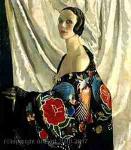Doris Clare Zinkeisen
Doris Clare Zinkeisen
Place: Rosneath
Born: 1898
Death: 1991
Biography:
Doris Clare Zinkeisen was a Scottish theatrical stage and costume designer, painter, commercial artist and writer. She was best known for her work in theatrical design.
Doris Zinkeisen was born in Clynder House in Rosneath, Argyll, Scotland. Her parents were Welsh-born Clare Bolton-Charles and Victor Zinkeisen, a timber merchant and amateur artist from Glasgow. Her father's family were originally from Bohemia and had been settled in Scotland for two hundred years. She had a younger sister, Anna Zinkeisen who also became an artist. The family left Scotland and moved to Pinner, near Harrow in 1909. Zinkeisen attended the Harrow School of Art for four years and won a scholarship to the Royal Academy Schools in 1917 together with her sister Anna.
Zinkeisen shared a studio in London with her sister during the 1920s and '30s from where she embarked on her career as a painter, commercial artist and theatrical designer.
Zinkeisen's realist style made her popular as a portraitist and she became a well-known society painter. The subject matter of her paintings, society portraiture, equestrian portraiture and scenes from the parks of London and Paris reflect the lifestyle of the upper class at the time.
She also worked widely in other media as an illustrator and commercial artist including producing advertising posters for several British railway companies, the London Underground and murals for the RMS Queen Mary.
In 1944, Doris and her sister Anna were commissioned by United Steel Companies (USC) to produce twelve paintings which were reproduced in the trade and technical press in Britain, Canada, Australia and South Africa. The images were subsequently collated in a book, This Present Age, published in 1946.
Zinkeisen produced a number of posters for London and North Eastern Railway (LNER), Southern Railway (SR) and the London, Midland and Scottish Railway (LMS) in the 1930s. The posters often featured historical themes and included:
In 1935, John Brown and Company Shipbuilders of Clydebank commissioned both of the Zinkeisen sisters to paint the murals in the Verandah Grill, a restaurant and night-club on the ocean liner the RMS Queen Mary. The murals, on the theme of entertainment, depicted circus and theatre scenes and can still be seen on the ship, now permanently moored in Long Beach, California. Zinkeisen was also involved in planning the interior decoration which featured a parquet dance floor surrounded by black Wilton carpets, star-studded red velvet curtains and a sweeping illuminated balustrade whose colours changed in time with the music. Writing in Vogue in 1936, Cecil Beaton described the Verandah Grill as ‘By far the prettiest room on any ship – becomingly lit, gay in colour and obviously so successful that it would be crowded if twice its present size’. The largest mural was damaged during World War II by gunnery officers tacking charts to the poster board covering the mural. After the war, Zinkeisen restored the mural and reportedly painted a mouse in the mural so there would always be a mouse on the Queen Mary, a dig at Cunard, which prided itself on having no rodents on their ships. Both sisters also contributed murals to the RMS Queen Elizabeth in 1940.
Zinkeisen exhibited at the Royal Academy in 1929, at the Royal Society of Portrait Painters in London and in Paris and the United States. She received Bronze (1929), Silver (1930) and Gold (1934) Paris Salon medals for her work. By 1929 she had been elected a member of the Royal Institute of Oil Painters (ROI).
Zinkeisen was a successful stage and costume designer for plays and films. Despite her success as a painter and commercial artist she was best known as a theatrical designer.
She started to work in stage design as soon as she completed her studies at the Royal Academy. Her first job was working for the actor-manager Nigel Playfair. Playfair wanted Zinkeisen to sing in the productions, but Zinkeisen insisted on remaining behind the scenes. One of the first plays she worked on was Clifford Bax and Playfair's 1923 adaptation of The Insect Play by Karel and Josef Čapek. The play ran for 42 performances in May and June 1923 at the Regent Theatre in London. Claude Rains played three roles and the production was the professional debut for John Gielgud. Rains described Zinkeisen as "a stunning women".
She became chief stage and costume designer for Charles B. Cochran's popular London revues. Cochran described her work in an article published in The Studio magazine in 1927.
Miss Doris Zinkeisen seems to me to follow the best traditions of English theatrical decoration... She can now create costumes for all moods and times, and capture with equal facility the acid fervour of puritanism or the sweet lyricism of a faun... this young decorator, at her early age is, in my opinion, in the front rank of British designers.
More...
Wikipedia link: Click Here














